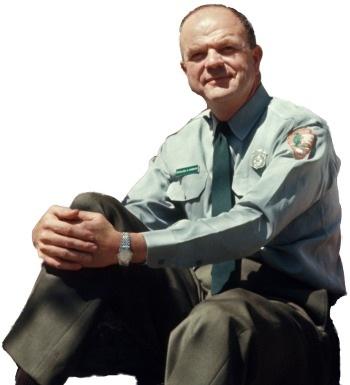Doug Hubbard, the chief naturalist at Yosemite National Park between 1955 and 1966 who had a knack for designing interpretive displays that appealed to all ages, has passed away at age 92.
Chief Hubbard's ties to the Park Service date to the summer of 1940, when he was an aide to Joseph Dixon, the director of the Yosemite School of Field Natural History, and he spent the summer of 1941 as a seasonal naturalist at Sequoia National Park.
After military duty during World War II, he returned home and transferred from the U.S. Border Patrol to the Park Service and was stationed at Millerton Lake in Friant, California. In 1947 he moved to Hawaii Volcanoes National Park, where in 1948 he was appointed chief naturalist. Another transfer brought him to Yosemite in 1952, and in 1955 he became the park's chief naturalist.
Perhaps the hallmark of his work at Yosemite was the Yosemite History Pioneer Center that arose at Wawaona in 1960. Allan Shields, who wrote a moving testimonial to Chief Hubbard in 2002 (attached below), noted in it that "thousands of visitors, perhaps millions, have enjoyed these rich cultural recreations of the nineteenth-century mountain life in Yosemite. With great effort and dedication, original buildings (cabins), were relocated from various sites in the park, arranged to comprise a kind of community, one which was actually occupied seasonally by 'volunteer' pioneers and actors pretending to be living in the 19th century, refusing to answer visitor questions out of their context. They baked fragrant bread in wood stoves, tended gardens, flocks of chickens, spun yarn on authentic spinning wheels, wove fabrics, and performed sundry other chores of daily life, exhibiting the quotidian experience of pioneer life."
Chief Hubbard's own account of how the Pioneer Center came about also is attached.
Chief Hubbard, among his many other accomplishments, also was behind the creation of the Happy Isles Nature Center, guided the renovation of the pioneer cemetery in the park and wrote a self-guiding historical tour booklet for it, bolstered the content of Yosemite Nature Notes through the addition of articles by naturalists, and helped bring the Yosemite Research Library to life.
Along with his wife, Fran, the naturalist created the Awani Press, which gave life to a series of books, including A Day with Tupi: An Indian Boy of Yosemite, and Animal Friends of the Sierra.
Conservation of Yosemite was always in his mind. Among his efforts to protect the park's resources were working to bring a stop to the "Glacier Fire Fall" that involved pushing a blazing pile of firewood and embers off Glacier Point to the delight of visitors down below in Curry Village, and calling for restrictions on where folks could park their vehicles.
So successful was he at Yosemite that Chief Hubbard was sent to Park Service headquarters in Washington in 1966. He worked first as Chief of the Division of Interpretation and Visitor Services and then as Deputy Director of NPS Interpretive Planning.
You can peer into Chief Hubbard's work at Yosemite at www.undiscovered-yosemite.com , a site maintained by his son, David, who was born and raised in Yosemite.
Services for Doug Hubbard were being held today in Fredricksburg, Texas.


 Support Essential Coverage of Essential Places
Support Essential Coverage of Essential Places







Comments
I'm sure Chief Hubbard is now conversing and comparing notes with the old naturalist ranger Carl Sharsmith. Both leave a great legacy to the National Parks and will be greatly missed.
I can't help but wonder if he played a role in the recent expansion and remodeling of the Nimitz Museum in Fredericksburg, Nimitz's home town. BTW, that is an outstanding museum of the Pacific War with a Japanese Peace Garden that is not to be missed.
For the record, my parents have old 12 mm? film of one of those firefalls off Galcier Point.
Is there any way that you could put that film on a web site somewhere? I know that's easy for me to say, since you would have to do the work. I know they had to stop the firefall because the crowds watching it were destroying the meadows near Curry.
Mr. Stefancik, you are correct. Doug was very much involved in the design and expansion of the Nimitz Museum in Fredericksburg, TX as well as the design of the LBJ National Historic Site, see the above attachment that was appended to the main article. This attachment is a copy of a 2002 interview with former park ranger-naturalist Alan Shields. It's the best reference I know of that highlights Doug Hubbard's numerous post NPS careers.
As a former Yosemite park ranger-naturalist myself, I would be thrilled to learn that Doug is now meeting and comparing notes with his former colleagues, Dr. Carl W. Sharsmith, Will Neely, and Bob Fry, with John Muir, Dr. Harold Bryant, and Doug's friend Ansel Adams looking on in approval.